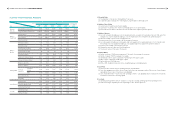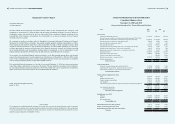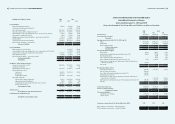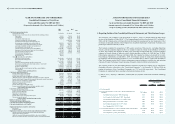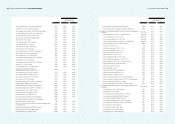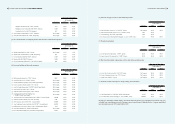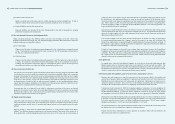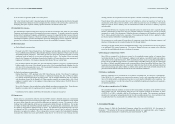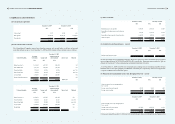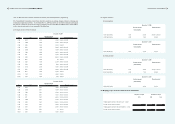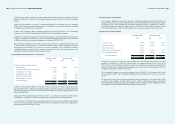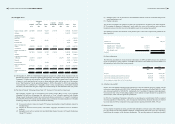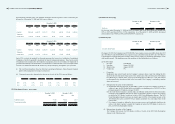Acer 2010 Annual Report Download - page 45
Download and view the complete annual report
Please find page 45 of the 2010 Acer annual report below. You can navigate through the pages in the report by either clicking on the pages listed below, or by using the keyword search tool below to find specific information within the annual report.
ACER INCORPORATED
2010 ANNUAL REPORT
86
FINANCIAL STANDING
87
(d) Financial assets carried at cost
Equity investments whose fair value cannot be reliably measured are carried at original cost. If there is
objective evidence which indicates that an equity investment is impaired, a loss is recognized.
(e) Financial liabilities measured at amortized cost
Financial liabilities not measured at fair value through profit or loss and not designated as hedging
instruments are measured at amortized cost.
(9) Derivative nancial instruments and hedging activities
Hedge accounting recognizes the offsetting effects on profit or loss of changes in the fair values of the
hedging instrument and the hedged item. The designated hedging instruments that conform to the criteria for
hedge accounting are accounted for as follows:
(a) Fair value hedges
Changes in the fair value of a hedging instrument designated as a fair value hedge are recognized in prot
or loss. The hedged item is also stated at fair value in respect of the risk being hedged, with any gain or
loss thereon recognized in prot or loss.
(b) Cash ow hedges
Changes in the fair value of a hedging instrument designated as a cash ow hedge are recognized directly
in equity. If a hedge of a forecasted transaction subsequently results in the recognition of an asset or
a liability, then the amount recognized in equity is reclassied into prot or loss in the same period or
periods during which the asset acquired or liability assumed affects prot or loss.
(10) Non-current assets held for sale
Non-current assets and groups of assets and liabilities which comprise disposal groups are classied as held
for sale when the assets are available for immediate sale in their present condition subject only to terms that
are usual and customary for sales of such assets (or disposal groups), and their sale within one year is highly
probable. Non-current assets or disposal groups classied as held for sale are measured at the lower of their
book value or fair value less costs to sell, and ceased to be depreciated or amortized. Non-current assets
or disposal groups classied as held for sale are presented separately on the consolidated balance sheets.
Interest and other expenses attributable to the liabilities of a disposal group classied as held for sale are
continued to be recognized until the related assets are disposed.
An impairment loss is recognized for any initial or subsequent write-down of the assets (or disposal
groups) to fair value less costs to sell in the consolidated statements of income. A gain from any subsequent
increase in fair value less costs to sell of an asset (or a disposal group) is recognized, but not in excess of the
cumulative impairment loss that has been recognized.
(11) Equity method investments
Long-term equity investments in which the Consolidated Companies, directly or indirectly, own 20% or
more of the investee’s voting shares, or less than 20% of the investee’s voting shares but are able to exercise
signicant inuence over the investee’s operating and nancial policies, are accounted for using the equity
method.
Effective January 1, 2006, under the amended ROC SFAS No. 5, “Long-term Investments under Equity
Method,” the difference between acquisition cost and carrying amount of net equity of the investee as of
the acquisition date is allocated proportionately based on the excess of fair value over the carrying value of
noncurrent assets on the investee’s books. Allocated amounts are amortized based on the method used for
the related assets. Any unallocated difference is treated as investor-level goodwill. If the allocation reduces
non-current assets to zero value, the remaining excess over acquisition cost is recognized as an extraordinary
gain. Prior to January 1, 2006, investor-level goodwill was amortized over ve years on a straight-line basis.
Commencing January 1, 2006, as required by the amended ROC SFAS No. 5, investor-level goodwill is no
longer amortized but tested for impairment.
Upon the sale of equity-method investment, the difference between the selling price and carrying amount
of the investment at the date of sale is recognized as a disposal gain or loss. In proportion to the percentage
disposed of, capital surplus and other equity adjustment items arising from the long-term investment are
debited against disposal gain or loss.
If an investee company issues new shares and the Company does not acquire new shares in proportion to
its original ownership percentage, the Company’s equity in the investee’s net assets will be changed. The
change in the equity interest is adjusted through the capital surplus and long-term investment accounts. If
the Company’s capital surplus is insufcient to offset the adjustment to long-term investment, the difference
is charged as a reduction of retained earnings.
Unrealized inter-company profits and losses resulting from transactions between the Consolidated
Companies and investees accounted for under the equity method are deferred to the extent of the Company’s
ownership. The prots and losses resulting from transactions relating to depreciable or amortizable assets
are recognized over the estimated useful lives of such assets. Prots and losses arising from transactions
relating to other assets are recognized when realized.
(12) Capital leases
For capital leases, where the Consolidated Companies act as the lessor, all periodic rental payments plus
bargain purchase price or estimated residual value are accounted for as lease payment receivables. The
present value of all lease payment receivables, discounted at the implicit interest rate, is recorded as revenue.
The difference between the lease payment receivables and the revenue is the unearned interest revenue,
which is recognized over the lease term using the effective interest method.
(13) Property, plant and equipment, property leased to others, and property not in use
Property, plant and equipment are stated at acquisition cost. Interest expense related to the purchase and
construction of property, plant and equipment is capitalized and included in the cost of the related asset.
Significant renewals, improvements and replacements are capitalized. Maintenance and repair costs are
charged to expense as incurred. Gains and losses on the disposal of property, plant and equipment are
recorded in the non-operating section in the accompanying consolidated statements of income.
Commencing from November 20, 2008, the Company capitalizes retirement or recovery obligation for
property and equipment in accordance with Interpretation (2008) 340 issued by the Accounting Research
and Development Foundation. A component which is signicant in relation to the total cost of the property
and equipment and for which a different depreciation method or rate is appropriate is depreciated separately.
Depreciation is provided for property, plant and equipment, property leased to others, and property not used
in operation over the estimated useful life using the straight-line method. The range of the estimated useful
lives of the respective classes of assets is as follows: buildings and improvements - 30 to 50 years; computer
equipment and machinery - 3 to 10 years; and other equipment - 3 to 20 years.
The estimated useful lives, depreciation method and residual value are evaluated at the end of each year and
any changes thereof are accounted for as changes in accounting estimates.
Property leased to others and property not used in operation is classied to other assets and continue to be
depreciated and are subject to an impairment test.



